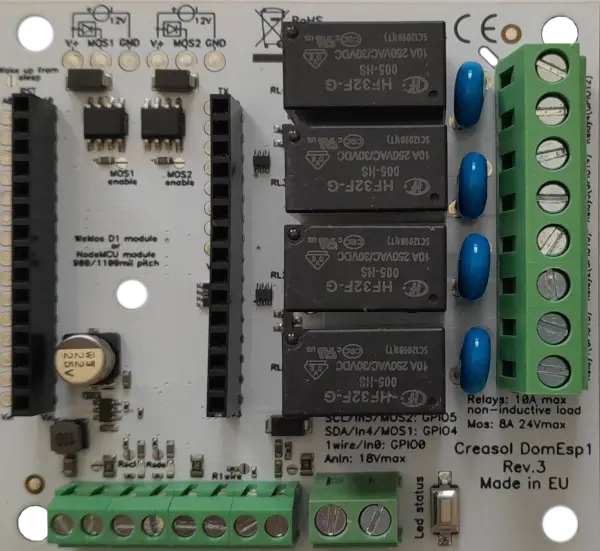ESP8266 è un MCU molto potente ed economico dotato di transceiver WiFi , molto utile per espandere gli ingressi/uscite di un sistema domotico.
La scheda Creasol DomESP1 è progettata per il modulo ESP8266 NodeMCU V3, con passo dei connettori da 900 mils (opzionalmente, saldando connettori aggiuntivi, è possibile utilizzare il modulo da 1100 mils o il mini modulo WeMos D1) e integra l'intero circuito per gestire ingressi digitali, un ingresso analogico, 4 uscite relè, bus I2C, bus 1wire e 2 uscite mosfet con capacità 8A 30Vmax.
Le uscite Mosfet sono condivise con i GPIO I2C, quindi non è possibile controllare sia il bus I2C che il Mosfet!
Per avere la versione più aggiornata, consultare la pagina in inglese.
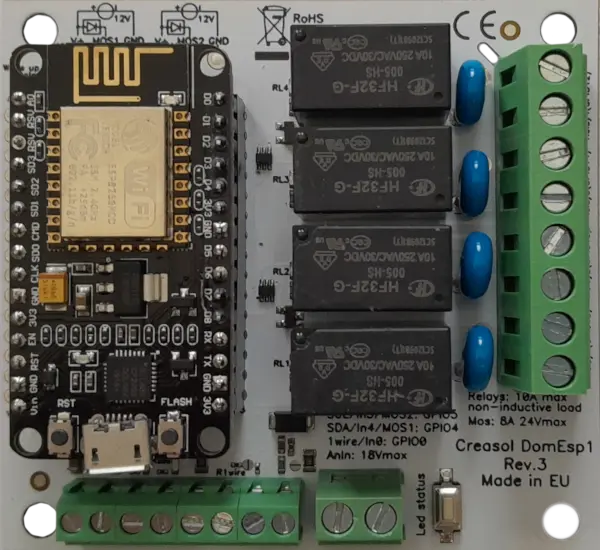 I LED sulle porte I2C e sulle uscite relè permettono di verificare lo stato della scheda e di rilevare eventuali problemi nei collegamenti dei cavi o nella configurazione del firmware: i LED vengono abilitati premendo il pulsante Test .
I LED sulle porte I2C e sulle uscite relè permettono di verificare lo stato della scheda e di rilevare eventuali problemi nei collegamenti dei cavi o nella configurazione del firmware: i LED vengono abilitati premendo il pulsante Test .
I LED abilitano la funzione e l'alimentatore switching consentono un controllo completo degli ingressi/uscite con un consumo energetico ottimizzato , anche se il modulo e il firmware ESP8266 non sono progettati per essere veramente "green".
Ogni relè consuma circa 450 mW di potenza: se sono necessari più relè, si consiglia di utilizzare dispositivi più intelligenti come Creasol DomBus31 , dotato di 6 uscite relè SPST da 250 V 5 A + 2 uscite relè SPDT da 10 A: DomBus31 consuma meno di 15 mW in standby e meno di 600 mW con tutti gli 8 relè accesi!
Il modulo ESP8266 può essere programmato con il firmware ESPEasy o un altro firmware adatto al modulo NodeMCU v3, come ESPHome , Tasmota , ...
Nel nostro store è possibile acquistare:
- la semplice scheda DomESP1 : il cliente deve acquistare e programmare autonomamente il modulo ESP8266, passo dell'intestazione 900 mil;
- la scheda DomESP1, con il modulo ESP8266 già programmato con l'ultimo firmware ESPEasy .
Dietro la scheda DomESP1 è disponibile la scheda DomESP2: è esattamente la stessa scheda, ma utilizza morsettiere plug-in (vedere l'immagine sotto).

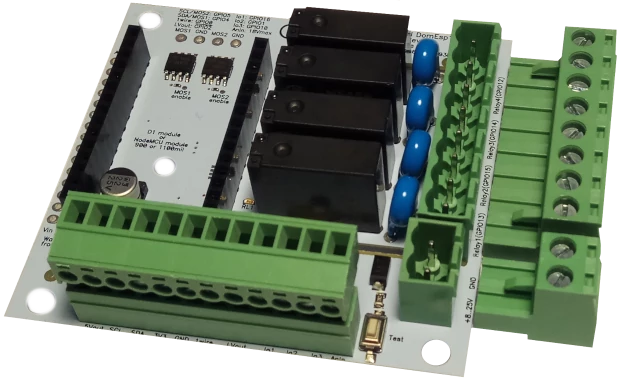
Caratteristiche
- 4 uscite relè (250 V 10 A max) con consumo energetico di 450 mW
- 1 ingresso analogico, 18 V max, funzione=%valore%*0,01828
- Bus 1wire (1Wire) che può essere utilizzato come GPIO normale
- Bus I2C (blocchi terminali SDA e SCL) che può essere utilizzato come GPIO normale ed è condiviso con mosfet da 12 A 30 V max, con capacità ON/OFF e dimmer
- 2 uscite MOSFET, open-drain, 12A 30V max, adatte per pilotare strisce LED e altri carichi DC, con funzione PWM. I MOSFET sono pilotati dagli stessi GPIO utilizzati per SDA e SCL, quindi MOSFET e I²C non possono essere utilizzati insieme.
- alimentatore switching, per ridurre il consumo/dissipazione di potenza, con tensione di ingresso 5-25Vdc
- Uscite da 5 Vdc e 3,3 Vdc disponibili sui morsetti
- consumo di corrente in standby (WiFi completamente operativo, relè e mosfet spenti): in genere 80 mA a 5 V CC, 40 mA a 12 V CC, 20 mA a 24 V CC
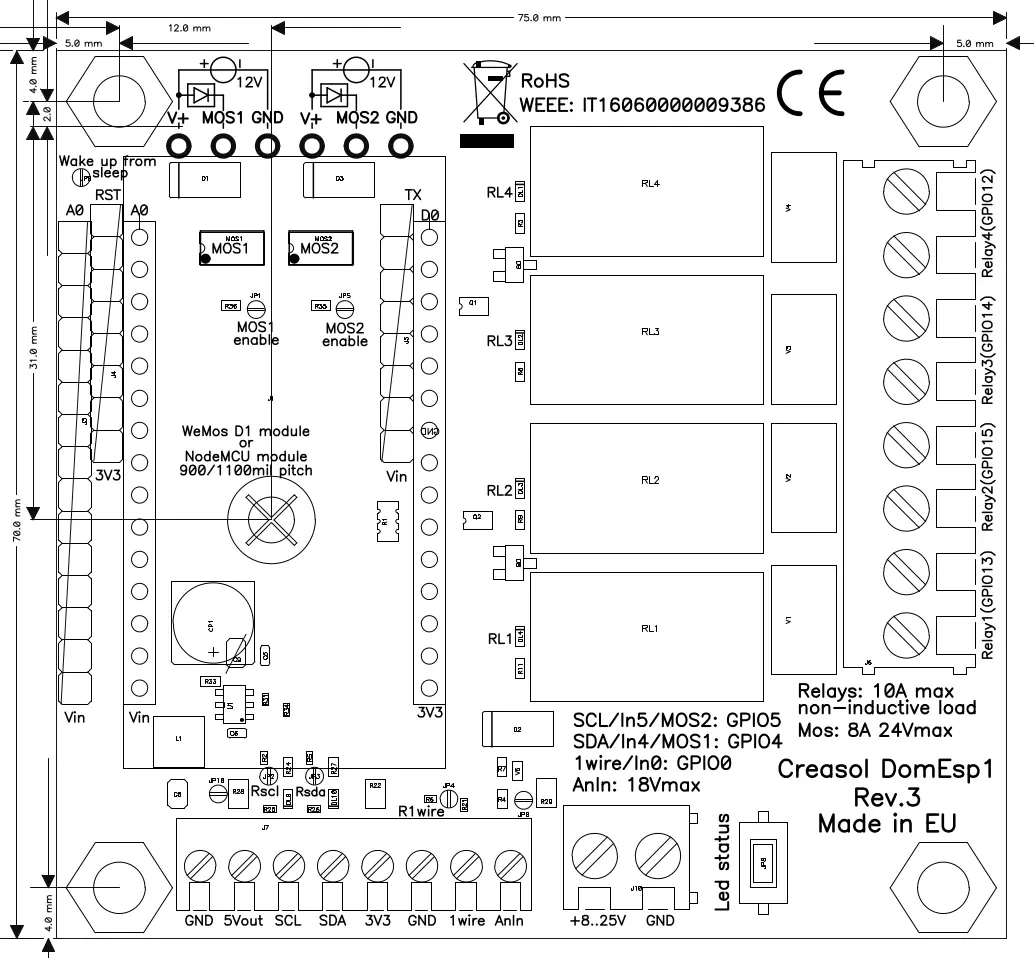
Vuoi di più per il tuo sistema domotico? Scopri i moduli DomBus:
- affidabile (collegato tramite cavo, come KNX e altri protocolli ad alta affidabilità)
- consumo energetico molto molto basso : 10÷15mW in standby (ESP8266 consuma 400mW in standby, shelly/sonoff consuma molto molto di più)
- latenza molto bassa , adatta per sensori di allarme e pulsanti (solo versione DomBus; la versione Modbus non è a bassa latenza)
- nessun inquinamento RF, nessuna batteria, nessuna disconnessioe, nessun dolore
- funziona con Domoticz (plugin), Home Assistant OS (componente aggiuntivo), Home Assistant , NodeRED , OpenHAB , ioBroker (bridge DomBusGateway tra il protocollo DomBus e MQTT-Autodiscovery) e altri sistemi che supportano il protocollo MQTT o Modbus .
Installazione di DomESP1
È possibile trovare la documentazione del processo di installazione (download del firmware e configurazione del dispositivo) all'indirizzo https://www.creasol.it/domesp1conf
Quando la scheda DomESP1 viene acquistata con il modulo NodeMCU, il firmware ESP-Easy , versione normale, è stato programmato nel modulo, quindi è pronto per l'uso.
Naturalmente è possibile riprogrammare un altro tipo di firmware (Tasmota, ESPHome, ...).
Per accedere al firmware ESP Easy, seguire i passaggi seguenti:
- ESP Easy si avvierà in modalità Access Point, con SSID ESP-Easy o simile e password configesp . Abilita il WiFi su uno smartphone o PC e connettiti all'SSID ESP-Easy o ESP_0 o simile, utilizzando la password configesp.
- Imposta l'SSID della rete WiFi a cui verrà connesso il dispositivo e la password WiFi associata, quindi fai clic sul pulsante Connetti .
- A questo punto, il dispositivo sarà associato alla rete WiFi selezionata con l'SSID e la password specificati.
- Esegui la scansione della rete per trovare l'indirizzo IP del dispositivo e connettiti ad esso tramite un browser: http://DEVICE_IP_ADDRESS

Note applicative
Scheda DomESP1 utilizzata per controllare una piscina
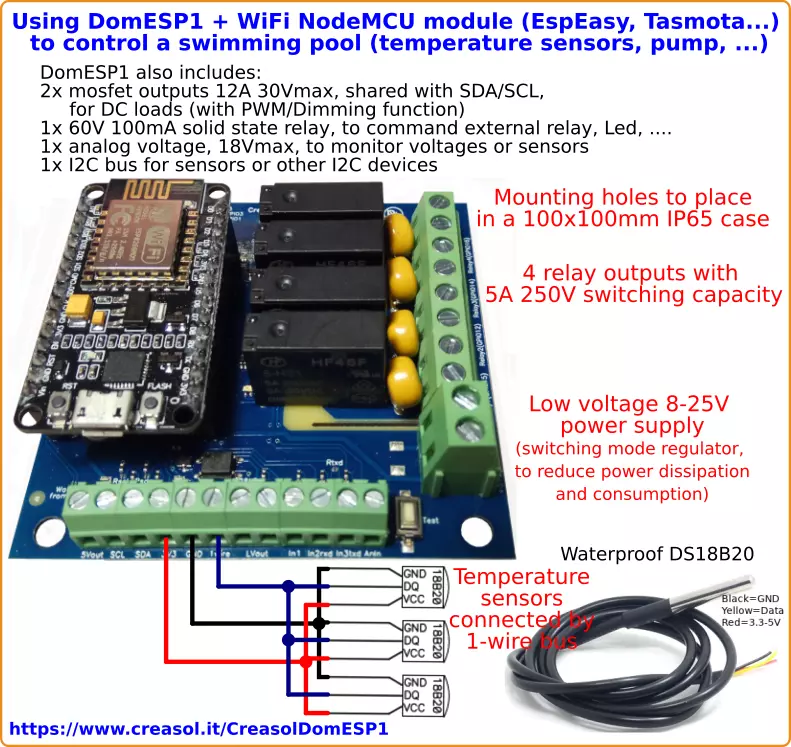
La scheda è perfetta per controllare pompe e sensori di temperatura , utilizzando un modulo WiFi NodeMCU con firmware ESPEasy o Tasmota .
La scheda è alimentata a bassa tensione, da 8 a 25Vdc, per garantire l'isolamento galvanico dalla rete: DomESP1 utilizza un regolatore switching mode per minimizzare il consumo e la dissipazione di potenza , molto utile considerando che il modulo NodeMCU consuma 400mW quando è in funzione.
Dispone di 4 relè con capacità 5A 250V che possono essere utilizzati per comandare fino a 4 attuatori (pompa, luci, ...) e supporta il bus 1wire per collegare 1 o più sensori di temperatura impermeabili DS18B20 (in parallelo).
Inoltre, integra 2 mosfet con capacità di 30 V 12 A per controllare carichi CC (con funzione PWM/dimming), 1 relè a stato solido con capacità di 60 V 100 mA , bus I²C per sensori e 1 ingresso analogico 18 V max .
Con il seguente script è possibile controllare la temperatura dell'acqua della piscina , utilizzando un tubo solare nero e una pompa per far ricircolare l'acqua calda e aumentare la temperatura dell'acqua fino al punto di regolazione desiderato.
--Domoticz script to control swimming pool water temperature
-- script executed every minute: name this file scripts/lua/script_time_swimmingpool.lua
DEVPUMP="name of pump device"
DEVTEMPA="name of temperature A"
DEVTEMPB="name of temperature B"
TEMPSET=30 -- temperature for the pool
commandArray={} -- list of command to sent to Domoticz when script ends
tempA=tonumber(otherdevices[DEVTEMPA])
tempB=tonumber(otherdevices[DEVTEMPB])
if (otherdevices[DEVPUMP]=='Off') then
-- pump is OFF
if (tempAtempA+5) then
-- must heat! tempB is 5 degrees > tempA
commandArray[DEVPUMP]='On'
end
else
-- pump is ON
if (tempA>TEMPSET or tempB<=tempA) then
commandArray[DEVPUMP]='Off'
end
end
return commandArray
Creasol DomESP1 collegato a un sistema di riscaldamento centralizzato
Il diagramma seguente mostra come collegare alcuni sensori di temperatura/umidità tramite bus 1wire per monitorare la temperatura ambiente e quella dell'acqua; ESP8266 controlla un'uscita a bassa tensione per abilitare/disabilitare il sistema di riscaldamento e 3 uscite per abilitare/disabilitare 3 pompe o valvole.
Questo è solo un esempio. Attraverso la connessione WiFi, il modulo ESP8266 installato su questa scheda comunicherà le temperature al controller Domoticz, che attiverà/disattiverà il sistema di riscaldamento centralizzato controllando le 3 zone di riscaldamento, attivando/disattivando la pompa corrispondente.
Per risparmiare ulteriormente sui consumi energetici , suggeriamo di utilizzare DomBus37 o DomBus38 , che dispongono di relè per la gestione del riscaldamento/pompa di calore e di numerosi ingressi per la misurazione della temperatura. I relè DomBus37 - DomBus38 consumano 50÷100mW ciascuno, quando sono accesi.
Per il massimo risparmio energetico, suggeriamo di utilizzare DomBus21 , che ha 3 relè ad alta potenza (3,5 kW max) che non consumano nulla quando sono accesi o spenti e 2 ingressi che possono essere utilizzati per misurare la temperatura.
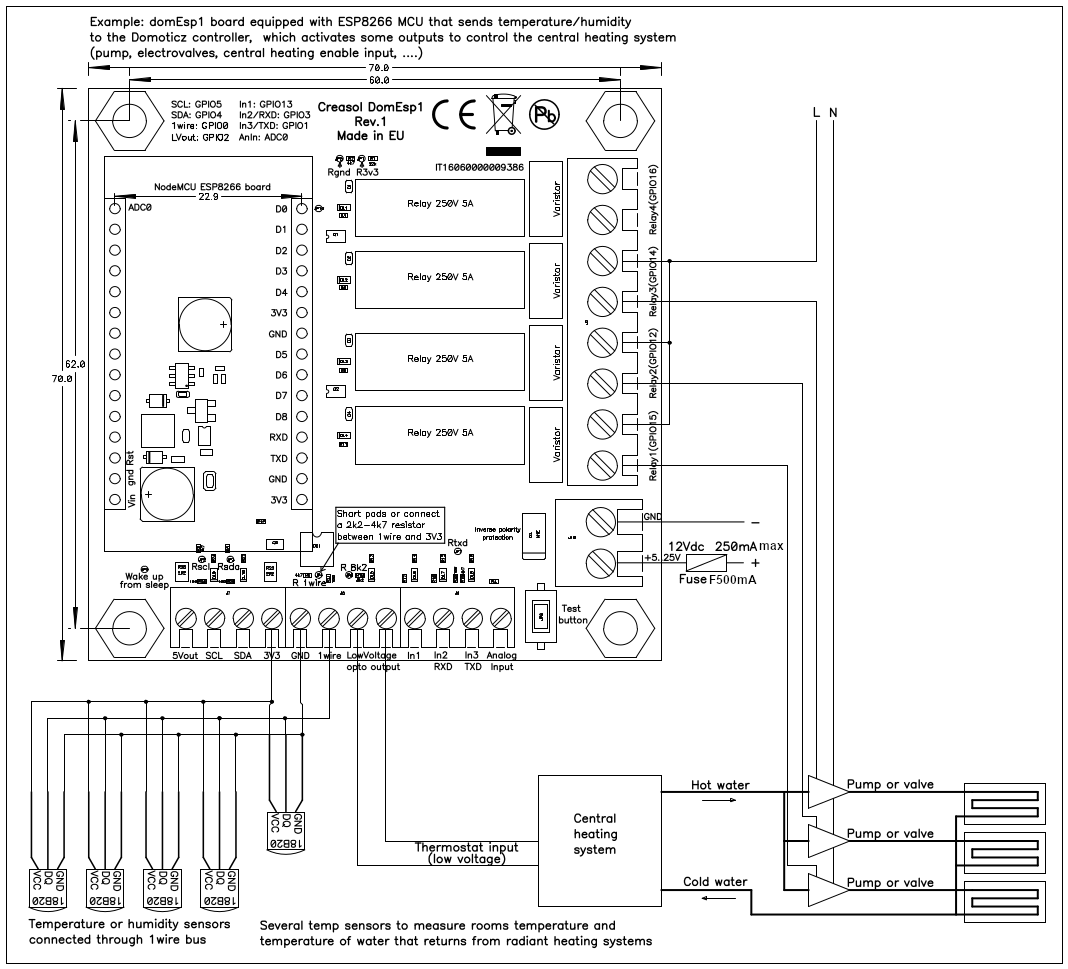
Utilizzo del mosfet per controllare le strisce LED tramite PWM
Le schede DomESP1 e DomESP2 hanno 2 mosfet, 30V 12A , che possono essere utilizzati per diverse funzioni.
In questa nota applicativa descriveremo come controllare una o due strisce di Led da 12/24Vdc tramite questi mosfet, che possono essere attivati come ON/OFF o come PWM per la dimmerazione .
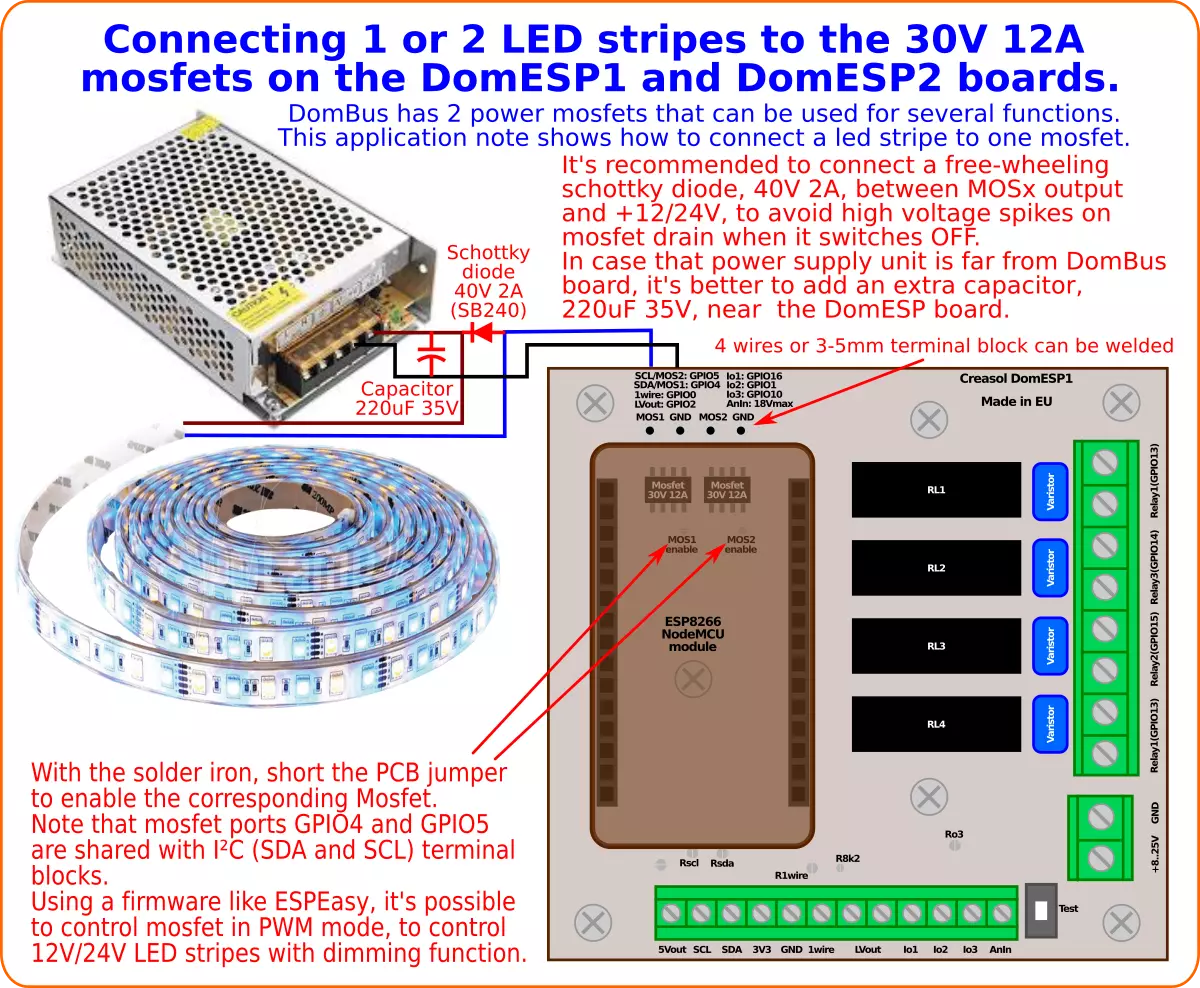
Utilizzando il firmware EspEasy sul modulo ESP8266, è possibile controllare l'uscita PWM tramite una chiamata http, utilizzando la sintassi
http://IP_OF_ESP_MODULE/control?cmd=pwm,GPIO,DUTY_CYCLE,FADING_TIME
Per esempio
http://192.168.1.123/control?cmd=pwm,4,512,1000
per impostare pwm su GPIO 4 (uscita MOS1), ciclo di lavoro al 50% (il valore varia da 0=Off a 1023=On), utilizzando un tempo di fading di 1000 ms (in modo che il ciclo di lavoro cambi gradualmente al valore impostato in 1 secondo).
In Domoticz è possibile creare un interruttore virtuale che può essere impostato (nel pannello Switchs) come SwitchType=Dimmer, quindi è possibile trovare una barra di scorrimento che può essere spostata da 0 a 100%. Per visualizzare questo valore percentuale su EspEasy è necessario seguire le istruzioni su https://www.domoticz.com/forum/viewtopic.php?t=20583
Gli N-Mosfet sono collegati in configurazione open-drain, con la sorgente collegata al foro GND , collegati insieme al piano di massa della scheda, in modo che i mosfet non siano separati galvanicamente dal resto della scheda.
Nel PCB si trovano due fori per ogni mosfet, uno contrassegnato come MOS1 che deve essere collegato al terminale V- della striscia di LED, e uno contrassegnato come GND che deve essere collegato al terminale V- dell'alimentatore. Il terminale V+ della striscia di LED deve essere collegato al terminale V+ dell'alimentatore 12/24V. Lo stesso vale per i fori MOS2 e GND , collegati al secondo mosfet. A questi 4 fori è possibile saldare fili o morsettiere con passo 3,5 mm.
Per abilitare l'uscita MOSFET, un ponticello sul PCB, contrassegnato come MOSx enable, deve essere cortocircuitato utilizzando il saldatore. MOS1 condivide lo stesso GPIO di SDA, mentre MOS2 condivide lo stesso GPIO di SCL, quindi abilitando un MOSFET si perde la possibilità di utilizzare SDA o SCL come input/output/I2C.
Per evitare picchi di alta tensione durante la commutazione del MOSFET da ON a OFF, si consiglia di collegare un diodo Schottky esterno a ricircolo libero da 2 A 40 V come indicato in figura. Inoltre, se l'alimentatore non è posizionato vicino alla scheda DomESP, è consigliabile aggiungere un condensatore da 220 uF 35 V sui cavi di alimentazione, vicino alla scheda DomESP, per ridurre al minimo il rumore condotto sui cavi di alimentazione.
Utilizzo di DomESP1 per leggere il consumo/produzione di energia da un contatore energetico e la temperatura tramite sensori di temperatura a 1 filo DS18B20
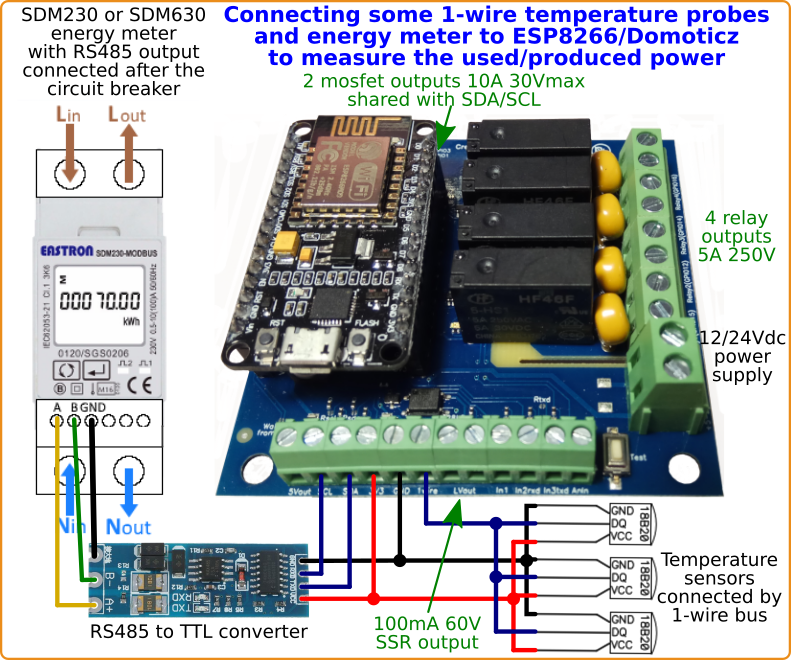
Hai bisogno di aiuto? Unisciti al canale DomBus su Telegram!

